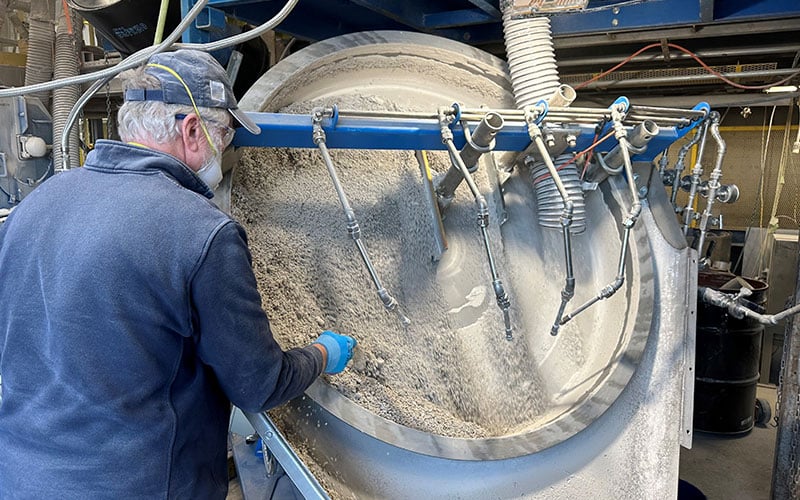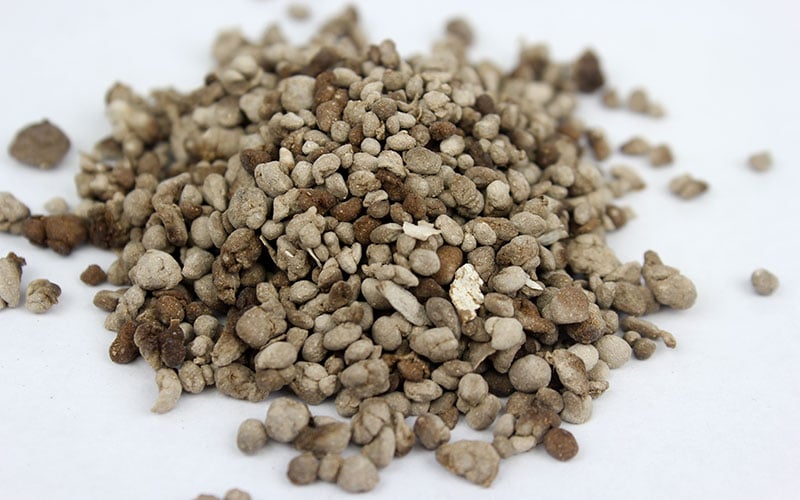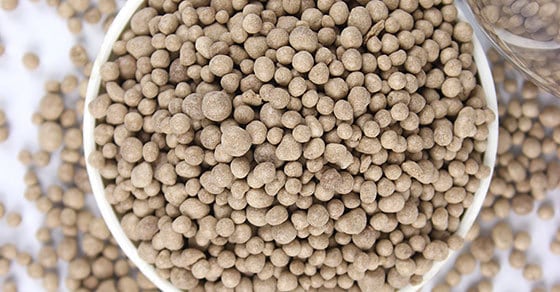Feedstock inconsistency is a major cause of issues in bulk solids processing operations. As such, ensuring a consistent feedstock is often the first step to mitigating potential problems, streamlining production, and improving end product quality.
A wide variety of complications may result from an inconsistent feedstock, making it difficult to pinpoint the source of the problem. For this reason, a process audit is the best way to identify and resolve the root cause of any production issue. Depending on the findings, a number of options may be available to address inconsistency. Test facilities that can simulate production conditions offer a valuable complement to process audits in identifying and confirming the best path to issue resolution.
Bulk Solids Processing Problems Caused by Inconsistent Feedstock
Variation in feedstock can cause a number of different issues, some of the most common of which include:
- Inconsistent product moisture
- Variation in product size
- Variation in product shape
- Increased off-spec product
- Inadequate crush strength
- Inadequate green strength
- Reduced output
- Decreased process efficiency
Additionally, any change in feedstock will continue to move through the production process, progressively affecting every step along the way.

A disc pelletizing test in progress in the FEECO Innovation Center
How Feedstock Characteristics Vary
Most commonly, operators recognize a processing issue as inconsistent moisture in the end product, or challenges in flowability. Both of these issues, however, most often stem from a lack of uniformity in the feedstock itself, of which many different characteristics may be the root cause.
The most common culprits in an inconsistent feedstock are moisture content, particle size distribution, and chemical composition.
Moisture Content
The moisture content of a material has far-reaching implications, affecting nearly every aspect of processing and product quality. This widespread effect makes variation in feedstock moisture content one of the most common causes of problems.
How Feedstock Moisture Affects Bulk Solids Agglomeration (Granulation)
Because tumble growth agglomeration relies on surface moisture to promote particle growth, moisture outside the identified range needed for the process to function properly can cause problems for those utilizing the technique in their bulk solids processing lines.
A moisture content that is too high may cause pellets to stick to each other resulting in clumping or raspberry-like agglomerates.

The “raspberry” or clump of pellets seen here is often indicative of an excess of moisture in the agglomeration process.
Excessive moisture can also cause a reduced green strength in pellets, yielding pellets that are not strong enough to withstand further processing without breaking down. Granules that break down before the end of the process not only result in inferior product, but also have the potential to clog downstream equipment.
Conversely, a moisture content that is too low will not allow pellets to sufficiently pick up fines for particle growth, making it difficult, or impossible, to reach the desired granule size and strength.
How Feedstock Moisture Affects Bulk Solids Drying
As the objective of a rotary dryer is to reach a target moisture range, or an exact percentage, varying moisture can be highly problematic; while rotary dryers are known for their ability to handle variation in feedstock, large swings in feed moisture will result in inconsistent moisture in the end product.
Additionally, a moisture content that is far outside of the range that the dryer was designed for can cause further problems; a moisture content that is too low may cause product to break down in the dryer, resulting in dust and an increase in off-spec product, while a moisture content that is too high could cause material to stick and “bake on” to the dryer’s interior, posing production challenges.
Particle Size Distribution
Particle size distribution also has the potential to significantly affect the balance of a process.
How Particle Size Distribution Affects Agglomeration
In agglomeration, particle size distribution must be within a specific range(s) (as defined by the material) in order to properly agglomerate. Additionally, this range needs to remain uniform to maximize production and quality of on-size product and consistency of the end product.
How Particle Size Distribution Affects Drying
In drying, a non-uniform particle size distribution could cause inconsistencies in the end product’s moisture content. The amount of on-spec product can be reduced, giving way to more product that is either too dry, not dry enough, or a combination thereof.
Chemical Composition
A material which varies in chemical composition often causes unpredictable results in the product and sometimes, the process itself. Depending on the material, a fluctuating chemical composition has the potential to change the way the material interacts with the process.
How Chemical Composition Affects Agglomeration
All materials respond to agglomeration in their own way as a result of their unique physical and chemical properties. Complicating matters further, is that materials may respond altogether differently when combined. This can have any number of effects, from preventing or facilitating agglomeration, to creating a pellet that is too weak or too strong, or even resulting in a heat-producing reaction. It is for these reasons that a thorough testing program should be carried out on representative samples prior to on-line production when developing a new process.
How Chemical Composition Affects Drying
Similarly, all materials interact with and hold water differently. A changing chemical composition in the drying process may impact the way a material retains or releases water. This could cause product to retain moisture too much, resulting in an inadequately dried product, or it could cause the material to release moisture in the dryer, resulting in production issues, downtime, and lost product.
Sources of Inconsistent Feedstock
There are many potential reasons why the characteristics of a feedstock may vary. Tracing the variability back to its source is essential for proper issue resolution.
Variability at the Source
Variation in feedstock can be a result of variability at the source, such as within a mineral deposit. Clays, for example, are notorious for the variation they exhibit, often varying significantly within the same deposit.
Inadequate Mixing
When multiple feedstock components are combined, inadequate (or a lack of) mixing can cause significant inconsistency in the feedstock.
This is sometimes seen when a disc pelletizer is not preceded by a pin mixer; as a disc is not meant to thoroughly mix materials, liquid binder and material feedstock continuously fed onto the rotating pan can yield a non-uniform distribution of the binder, ultimately creating an inconsistent end product. The addition of a pin mixer pre-mixes the material, producing a uniform feedstock for the pelletizer.

The sample in this photo shows an uneven distribution of binder due to inadequate mixing
Particle Segregation
Particle segregation, or the redistribution of particles into a non-homogeneous mixture, can occur during shipping, handling, or storage. This segregation is a result of particle size and density and is often seen with feedstocks of varying product characteristics that cause like particles to group together.
Mechanical Incompatibility or Failure
In some cases, a non-uniform feedstock may even be the result of a mechanical failure. A common example of this lies in the binder spray system of an agglomeration process. Binder spray systems are intended to spray an even distribution of binder onto the material for maximum uniformity. If the proper nozzle type is not selected, binder distribution may not be adequate. Similarly, if nozzles become clogged, distribution may become highly variable.
Addressing Feedstock Uniformity Issues with a Process Audit
With the myriad of potential causes associated with bulk solids processing problems, assessing where an inconsistency is originating from can be a complex task. And while it can sometimes be systematically identified from practices such as comparing feedstock with nameplate specifications, sampling material throughout processing stages, and analyzing process data, it is most effectively approached through a process audit.
FEECO Customer Service Engineers offer process audits to troubleshoot issues, assess a potential change in production conditions, or simply to optimize the process for maximum efficiency. Backed by decades of experience, our Customer Service Engineers can assess a process and make a variety of recommendations depending on the objectives.
What to Expect from a Process Audit
While a process audit will differ depending on the type of process and the goals of the audit, as well as the provider, audits generally begin with the process engineer reviewing process data and discussing the process with the plant’s engineers and operators.
The engineer then systematically explores the potential variables to determine where an issue might be originating. Upon a thorough analysis, the engineer will likely provide a comprehensive report, complete with the steps recommended to resolve any occurring issues. The information given also serves as valuable benchmark data.
Options for Improving Feedstock Uniformity
Depending on the issue, several options for improving feedstock uniformity may be available. Some of the most common methods are outlined below.
Back Mixing
Back mixing refers to a practice in which dried material is recycled and mixed with the feedstock, typically via a pugmill mixer. This helps to balance out varying moisture content by bringing down the higher moisture levels so the range in variation is smaller.
Improve Mixing
Mixing is a highly effective method to improve feedstock uniformity. In some cases, the addition of a mixer to the beginning of the process can mitigate issues by ensuring that feedstock components are uniformly mixed to create a homogeneous mixture.
Like back mixing, mixing components of varying moisture contents can balance out the overall moisture content of the feedstock for consistency.
Pre-drying
The addition of a pre-drying step to the process can also improve varying moisture content.
Addressing the Source
When feedstock varies at its source, inconsistencies may be addressed with the vendor. The vendor may be purchasing from several suppliers, or may have a processing issue at the original production site that needs to be addressed.
Testing the Process
Depending on the complexity of the problem, the engineer may recommend testing be conducted in a facility such as the FEECO Innovation Center.
Testing can be used to evaluate the available options and determine the process variables necessary to bring the process back to a balanced state. Test facilities like the Innovation Center can simulate the conditions of a commercial production process, allowing for a controlled and systematic approach to confirming the audit findings and expediting a resolution, without affecting the live production environment.
Benefits of a Uniform Feedstock
As there are many ways in which feedstock characteristics influence the process, there are a number of potential benefits to improving feedstock uniformity. This might include:
- Improved end product quality
- Increased consistency of the end product
- Improved process efficiency
- Reduced downtime and maintenance
- Reduced product waste
- Reduced re-processing
Conclusion
Inconsistency in feedstock is a common source of process instabilities and product variation when drying or agglomerating bulk solids. As such, a uniform feedstock is essential to maximizing production efficiency and minimizing lost product and downtime.
FEECO offers comprehensive process audits for agglomeration and drying operations to optimize production, troubleshoot issues, and improve end product quality, even if the equipment was not built by FEECO. Our well-equipped testing facility serves as a valuable asset in confirming findings and resolving the issue. For more information on our process audits, contact us today!



